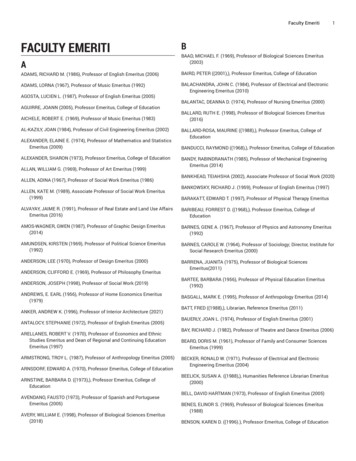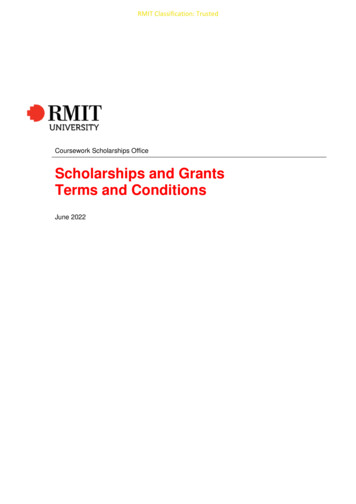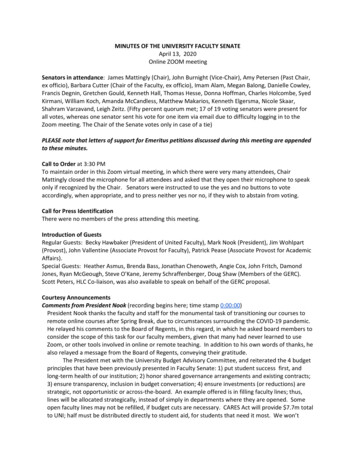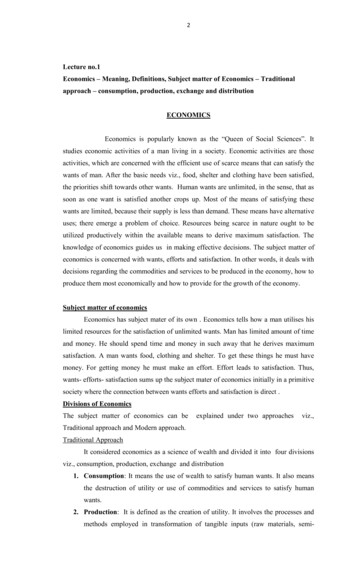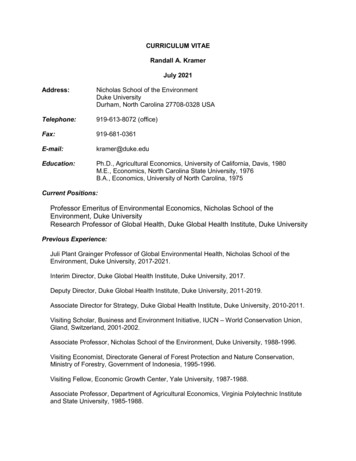
Transcription
CURRICULUM VITAERandall A. KramerJuly 2021Address:Nicholas School of the EnvironmentDuke UniversityDurham, North Carolina 27708-0328 USATelephone:919-613-8072 ation:Ph.D., Agricultural Economics, University of California, Davis, 1980M.E., Economics, North Carolina State University, 1976B.A., Economics, University of North Carolina, 1975Current Positions:Professor Emeritus of Environmental Economics, Nicholas School of theEnvironment, Duke UniversityResearch Professor of Global Health, Duke Global Health Institute, Duke UniversityPrevious Experience:Juli Plant Grainger Professor of Global Environmental Health, Nicholas School of theEnvironment, Duke University, 2017-2021.Interim Director, Duke Global Health Institute, Duke University, 2017.Deputy Director, Duke Global Health Institute, Duke University, 2011-2019.Associate Director for Strategy, Duke Global Health Institute, Duke University, 2010-2011.Visiting Scholar, Business and Environment Initiative, IUCN – World Conservation Union,Gland, Switzerland, 2001-2002.Associate Professor, Nicholas School of the Environment, Duke University, 1988-1996.Visiting Economist, Directorate General of Forest Protection and Nature Conservation,Ministry of Forestry, Government of Indonesia, 1995-1996.Visiting Fellow, Economic Growth Center, Yale University, 1987-1988.Associate Professor, Department of Agricultural Economics, Virginia Polytechnic Instituteand State University, 1985-1988.
2Assistant Professor, Department of Agricultural Economics, Virginia Polytechnic Institute andState University, 1980-1985.Post Graduate Research Agricultural Economist, University of California, Davis, 1978-1980.Professional Societies:Association of Environmental and Resource EconomistsAmerican Agricultural Economics AssociationHonorary Societies:Phi Beta KappaPhi Eta SigmaGamma Sigma DeltaSigma XiSelected Professional Activities:2017- 2019:Chair, Environmental Economics and Policy Program, Nicholas School(1990-92,1996-98, 2002-07 and 2017-2019)2014 - 2019:Board of Directors and Treasurer, Triangle Global Health Consortium2014 - 2017:Talent (education) Domain Co-Leader, Amsterdam Health and TechnologyInstitute2012 - 2015:Bass Connections in Global Health Theme Leader, Duke University2011 - 2015:Member, National Advisory Environmental Health Science Council, NationalInstitutes of Health.2009 - 2015:Faculty Leader, Global Environmental Health Signature ResearchInitiative, Duke Global Health Institute.2007-2014:Editorial Board, Journal of Natural Resources Policy Research.2007:Consultant to the Organization for Economic Cooperation andDevelopment (OECD) for report on international cost-sharing forbiodiversity conservation.2004-2005:Advisor to the World Health Organization on Reporting of DDT UseUnder the Stockholm Convention on Persistent Organic Pollutants2001-2004:Consultant to the International Union for the Conservation of Nature (IUCN) oneconomic incentives for biodiversity conservation in Bulgaria and Romania.2001-2008:Consultant to the World Bank Group on efforts to encourage private sectorbiodiversity conservation in Tanzania, Mozambique and Mongolia.1999-2000:Chair, Division of Environmental Sciences and Policy, Nicholas School
31999-2007:Board of Directors, Coral Reef Alliance1998-2001:Board of Directors, Association of Environmental and Resource Economists1998-2011:Consultant to the World Bank Group on ecotourism and sustainable financingfor Komodo National Park, Indonesia.1998:Consultant to the Packard Foundation on the development of a marine andcoastal biodiversity funding strategy.1992-1995:Director of Undergraduate Studies, Environmental Sciences and PolicyProgram, Duke University.1994-1995:Consultant to Winrock International and U.S. Agency for InternationalDevelopment for a report on the economics of biodiversity1992:Consultant to the Asian Development Bank on Indonesia BiodiversityConservation Project.1990-1991:Consultant to the World Bank on the preparation of a global forest policypaper.1989-1995:Editorial Board, Journal of Sustainable Agriculture.1986-1987:Consultant to U.S. Fish and Wildlife Service on economic analysis ofwetlands.1985-1988:Consultant to U.S. Department of the Interior, Office of Policy Analysis,Washington, D.C., for economic analysis on a congressionally mandatedstudy of the effects of federal policies on the preservation and development ofwetlands.1985:Consultant to U.S. Agency for International Development to provide technicalassistance on research and graduate instruction to the Post Graduate Instituteof Agriculture, University of Peradeniya, Sri Lanka.1984:Consultant to the Organization of American States, Washington, D.C. forpreparation of manual on incorporating natural disaster information intobenefit-cost analysis.1982:Consultant to International Food Policy Research Institute, Washington,D.C., for preparation of report on crop insurance programs.Primary Research Interests:Environmental EconomicsGlobal Environmental HealthEcosystem ServicesBenefit-Cost AnalysisEnvironmental Policy Analysis
4Economic DevelopmentCourses Taught:Planetary Health: Ecosystems, Human Health and PolicySocial Science Surveys for Environmental ManagementEconomics of Environmental ManagementEnvironmental Social Sciences Research WorkshopEconomic Analysis of Environmental PolicyResource and Environmental EconomicsAdvanced Environmental EconomicsIntroduction to Environmental Sciences and PolicyResource and Environmental PolicySeminar on Economic Valuation of the EnvironmentSeminar on Biodiversity ManagementSeminar on Environmental EquityAwards:Duke University Scholar/Teacher of the Year, 2004Outstanding Teacher of the Year, 1989 and 1998, Nicholas School of theEnvironmentBooks:X.N. Zhou, R. Kramer, and W.Z. Yang, editors, Malaria Control and EliminationProgram in the People's Republic of China, Advances in Parasitology, vol. 86, 1360 (2014).R.A. Kramer, C. van Schaik, and J. Johnson, editors, Last Stand: ProtectedAreas and the Defense of Tropical Biodiversity, Oxford University Press, 1997.Articles and Chapters:J.P. Herrera, J.Y. Rabezara, N. Ravelomanantsoa, M. Metz, C.France, A. Owens, M.Pender, C. L. Nunn, and R.A. Kramer. "Food insecurity related to agricultural practicesand household characteristics in rural communities of northeast Madagascar." FoodSecurity (2021): 1-13.L. Olander, S. Mason, H. Tallis, J. Lamb, Y. Masuda, and R. Kramer, “Climate Change,Ecosystem Services and Human Health,” in G. Luber and J. Lemery (eds): GlobalClimate Change & Human Health: From Science to Practice. Jossey-Bass (2021)C. Nunn, A. Solis, S. Rakotonarivo, C. Golden, and R. Kramer, "One Health andResearch Practice in Madagascar", in S. Goodman (Ed): The Natural History ofMadagascar. University of Chicago Press (forthcoming, 2021)N. Berlin Rubin, L. Mboera, A. Lesser, M. Miranda, and R. Kramer." Process Evaluationof a Community-Based Microbial Larviciding Intervention for Malaria Control in RuralTanzania." International Journal of Environmental Research and Public Health 17.19(2020): 7309.
5E. Khandekar, R. Kramer, A. Ali, A., A. Al-mafazy, J. Egger, S. LeGrand, H. Mkali, M.McKay, J. Ngondi, “Evaluating Response Time in Zanzibar’s Malaria Elimination Casebased Surveillance-Response System.” American Journal of Tropical Medicine andHygiene 100 (2019): 256.J. Cole, J. McDonald, X. Wen, R. Kramer, “Marketing Energy Efficiency: PerceivedBenefits and Barriers to Home Energy Efficiency.” Energy Efficiency (2018) 11: 18111824.Z.S. Brown and R.A. Kramer, “Preference Heterogeneity in the Structural Estimation ofEfficient Pigovian Incentives for Insecticide Spraying to Reduce Malaria,” Environmentaland Resource Economics 70 (2018): 169–190.R. Kramer and D.E. Mercer, "Valuing a Global Environmental Good: U.S. Resident'sWillingness to Pay to Protect Tropical Rain Forests." The Stated Preference Approach toEnvironmental Valuation: Volume III: Applications: Benefit-Cost Analysis and NaturalResource Damage Assessment (2018): 275–89. (reprinted from original 1997publication)J. Bartlett, Cao, S., Mmbaga, B., Qian, X., Merson, M., Kramer, R. “Strengthening anAcademic Global Health Network through a Partnership Conference.” Annals of GlobalHealth 83 (2017): 630-636R.A, Simmons, L. Mboera, M. Miranda, A. Morris, G. Stresman, E. Turner, R. Kramer, C.Drakeley, W.P. O’Meara, “A Longitudinal Cohort Study of Malaria Exposure andChanging Serostatus in a Malaria Endemic Area of Rural Tanzania,” Malaria Journal 16(2017): 309.D.A., Miteva, R.A. Kramer, Z. Brown, and M. Smith, “A Spatial Model of HouseholdFuelwood Extraction in Northern Uganda,” American Journal of Agricultural Economics99 (2017): 1008-1026.S.K. Pattanayak, R.A. Kramer, and J.R. Vincent, “Ecosystem Change and HumanHealth: Implementation Economics and Policy,” Philosophical Transactions B (2017):372:1722.Z.S. Brown, R.A. Kramer, D. Ocan, and C. Oryema, “Household Perceptions andSubjective Valuations of Indoor Residual Spraying Programs to Control Malaria inNorthern Uganda,” Infectious Diseases of Poverty 5 (2016): 100-113.S.L. Macdonald, R.L. Lewison, S.E. Roady, R.A. Kramer, D. Rigling-Gallagher, and A.J.Read, “Comparing Stakeholder Perceptions with Empirical Outcomes from NegotiatedRulemaking Policies: Is Participant Satisfaction a Proxy for Policy Success?,” MarinePolicy 73 (2016): 224-230.R. Rahman, A. Lesser, L. Mboera, and R. Kramer, “Cost of Microbial Larviciding forMalaria Control in Rural Tanzania,” Tropical Medicine & International Health 21 (2016):1468-1475.D. Kim, Z. Brown, R. Anderson, C. Mutero, M.L. Miranda, J. Wiener, and R. Kramer,
6“The Value of Information in Decision-Analytic Modeling for Malaria Vector Control inEast Africa,” Risk Analysis 37 (2016): 231-244.L. Olander, S. Mason, H. Tallis, J. Lamb, Y. Masuda, and R. Kramer, “Climate Change,Ecosystem Services and Human Health,” in G. Luber and J. Lemery (eds): GlobalClimate Change & Human Health: From Science to Practice. Jossey-Bass (2015)C.J. Paul, R.A. Kramer, A. Lesser, C.M. Mutero, M.L. Miranda, and K. Dickinson,“Identifying Barriers in the Malaria Control Policymaking Process in East Africa: Insightsfrom Stakeholders and a Structured Literature Review,” BMC Public Health 15 (2015):862- 870.R.A. Kramer and A. Lesser, "Sustaining the Gains Made in Malaria Control andElimination," Infectious Diseases of Poverty 4 (2015): 26-28.X.N. Zhou, Z.G. Xia, R.B. Wang, Y.J. Qian, S.S. Zhou, J. Utzinger, M. Tanner, R.Kramer, and W.Z. Yang, “Feasibility and Roadmap Analysis for Malaria Elimination inChina,” 21-46, chapter 2 in Malaria Control and Elimination Program in the People'sRepublic of China, X.N. Zhou, R. Kramer, and W.Z. Yang, editors, Advances inParasitology, 86 (2014):1-360.Z.G. Xia, L. Zhang, J. Feng, M. Li, X.Y. Feng, L.H. Tang, S.Q. Wang, H.L. Yang, Q. Gao,R. Kramer, T. Ernest, P. Yap, and X.N. Zhou, “Lessons from Malaria Control toElimination: Case Study in Hainan and Yunnan Provinces,” 47-79, chapter 3 in MalariaControl and Elimination Program in the People's Republic of China, X.N. Zhou, R.Kramer, and W.Z. Yang, editors, Advances in Parasitology, 86 (2014):1-360.C. Mutero, R. Kramer, C. Paul, A. Lesser, M.L. Miranda, L.E.G. Mboera, and B.Ameneshewa, "Factors Influencing Malaria Control Policy-making in Kenya, Uganda andTanzania," Malaria Journal 13 (2014): 305-405.R.A. Kramer, L.E.G. Mboera, K. Senkoro, A. Lesser, E.H. Shayo, C.J. Paul, and M.L.Miranda, "A Randomized Longitudinal Factorial Design to Assess Malaria Vector Controland Disease Management Interventions in Rural Tanzania," Int. J. Environ. Res. PublicHealth 11 (2014): 5317-5332.L.E.G. Mboera, R.A. Kramer, M.L. Miranda, S.P. Kilima, E.H. Shayo, and A. Lesser,“Community Knowledge and Acceptance of Larviciding for Malaria Control in a RuralDistrict of East-Central Tanzania,” Int. J. Environ. Res. Public Health 11 (2014): 51375154.R. Kramer, A. Jenkins, and A. Lesser, “The Role of Ecosystem Service Payments inAchieving Conservation Goals: Attitudes Among Farm Operators,” chapter in ValuingEcosystem Services – Methodological Issues and Case Studies, K.N. Ninan, editor,Cheltenham: Edward Elgar Publishers (2014): 395-413.L.E.G. Mboera, H.D. Mazigo, S.F. Rumisha, and R.A. Kramer, “Towards MalariaElimination and its Implication for Vector Control, Disease Management and Livelihoodsin Tanzania,” Malaria World Journal 4 (2013): 1-14.Z. Brown, K. Dickinson, and R. Kramer, “Insecticide Resistance and Malaria Vector
7Control: The Importance of Fitness Cost Mechanisms in Determining EconomicallyOptimal Control Trajectories,” Journal of Economic Entomology 106 (2013): 366-374.D. Kim, K. Fedak, and R. Kramer, “Reduction of Malaria Prevalence by Indoor ResidualSpraying: A Meta-Regression Analysis,” American Journal of Tropical Medicine andHygiene 87 (2012): 117-124.C.M. Mutero, D. Schlodder, N. Kabatereine and R. Kramer, “Integrated VectorManagement for Malaria Control in Uganda: Knowledge, Perceptions and PolicyDevelopment,” Malaria Journal 11 (2012): 21-31.K.L. Dickinson, H.F. Randell, R.A Kramer, E.H. Shayo, “Socioeconomic Status andMalaria-related Outcomes in Mvomero District, Tanzania,” Global Public Health 4 (2012):384-99.H. Randell, K. Dickinson, E. Shayo, L. Mboera, and R. Kramer, “EnvironmentalManagement for Malaria Control: Knowledge and Practices in Mvomero, Tanzania,”EcoHealth 7 (2010): 507–516.W.A. Jenkins, B.C. Murray, R.A. Kramer, and S. P. Faulkner, “Valuing EcosystemServices from Wetland Restoration in the Mississippi Alluvial Valley,” EcologicalEconomics 69 (2010): 1051-1061.Y. Kraus Elsin, R.A. Kramer, W.A. Jenkins, “Valuing Drinking Water Provision as anEcosystem Service in the Neuse River Basin,” Journal of Water Resources Planning andManagement 136 (2010): 474-482.R.A. Kramer, “Forests and Biodiversity: An Alternative View,” chapter 4 in LatinAmerican Development Priorities: Costs and Benefits, Bjorn Lomborg, editor, CambridgePress (2010): 227-234.R.A. Kramer, K.L. Dickinson, R.M. Anderson, V.G. Fowler, M.L. Miranda, C.M. Mutero,K.A. Saterson, and J.B. Wiener, “Using Decision Analysis to Improve Malaria ControlPolicy Making,” Health Policy 92 (2009): 133-140.R.A. Kramer, J.I. Eisen-Hecht, and G.E. Vaughn, “Economics of EcosystemManagement for the Catawba River Basin,” chapter 6 in Environmental Economics forWatershed Protection, H. Thurston, M.T. Heberling and A. Schrecongost, editors,CRC/Taylor Francis Press, 2009.R.A. Kramer, E.O. Sills, and S.K. Pattanayak, “National Parks as Conservation andDevelopment Projects: Gauging Local Support,” chapter 7 in Conserving and ValuingEcosystem Services and Biodiversity - Economic, Institutional and Social Challenges,K.N. Ninan, editor, London: Earthscan Press (2009) 113-134.K.K. Karanth, R.A. Kramer, S.S. Qian, and N.L. Christensen, “Examining ConservationAttitudes, Perspectives, and Challenges in India,” Biological Conservation, 41 (2008):2357-67.R. A. Kramer, “Economic Valuation of Ecosystem Services,” chapter 11 in SageHandbook of Environment and Society, Jules Pretty, et al. editors, Sage Publications
8(2008): 172-180.C. Liese, M.D. Smith, and R.A. Kramer, “Open Access in a Spatially Delineated ArtisanalFishery: The Case of Minahasa, Indonesia,” Environment and Development Economics,12 (2007):123-143.S. Pattanayak, K. Dickinson, C. Corey, B. Murray, E. Sills, and R. Kramer,“Deforestation, Malaria, and Poverty: A Call for Transdisciplinary Research to Supportthe Design of Cross-sectoral Policies,” Sustainability: Science, Policy and Practice 2(2006): 45-56.I. Kochi, B. Hubbell, and R. Kramer, “An Empirical Bayes Approach to Combining andComparing Estimates of the Value of a Statistical Life for Environmental Policy Analysis,”Environmental and Resource Economics 34 (2006): 385-406.S. Cassels, S. Curran, and R.A. Kramer. “Do Migrants Degrade Coastal Environments?Migration, Natural Resource Extraction, and Poverty in North Sulawesi, Indonesia.”Human Ecology 3 (2005): 329-363.K. Saterson, N.L. Christensen, R.B Jackson, R.A. Kramer, S.L. Pimm, M.D. Smith, andJ.B. Wiener, “Disconnects in Evaluating the Relative Effectiveness of ConservationStrategies, Conservation Biology 18 (2004): 597-599.S.K. Pattanayak, E.O. Sills and R.A. Kramer, “Seeing the Forest for the Fuel,”Environment and Development Economics 9 (2004): 155-179.S.K. Pattanayak, E.O. Sills, A.D. Mehta, and R.A. Kramer, “Local Uses of Parks:Uncovering Patterns of Household Production from Forests of Siberut, Indonesia,”Conservation and Society 1 (2003): 209-222.R.A. Kramer and S.M.H. Simanjuntak, “Human Migration and Resource Use In SulawesiFishing Communities,” in Proceedings of the Ninth International Coral Reef Symposium,Bali, Indonesia, 2000, Indonesian Institute of Sciences, 2 (2003) : 739-740R. Kramer, T. Holmes and M. Haefele, “Contingent Valuation Estimation of ForestEcosystem Protection,” E. Sills and K. Abt (eds.) Forests in a Market Economy. KluwerAcademic Publishers, Dordrecht, Netherlands, 72 (2003): 303-320.R.A. Kramer and J.I. Eisen-Hecht, “Estimating the Economic Value of Water Quality inthe Catawba River Basin,” Water Resources Research 38 (2002): 1-10.R.A. Kramer, S.M.H. Simanjuntak, and Christopher Liese, “Migration and Fishing inIndonesian Coastal Villages,” Ambio 31(2002): 367-371.T. Arin and R.A. Kramer, “Divers’ Willingness to Pay to Visit Marine Sanctuaries: AnExploratory Study,” Ocean and Coastal Management 45 (2002): 171-183.R. Kramer, J. Langholz, and N. Salafsky, “The Role of the Private Sector in ProtectedArea Establishment and Management: A Conceptual Framework for AnalyzingEffectiveness,” chapter 4 in Making Parks Work: Strategies for Preserving TropicalNature, J.T. Terborgh, C. van Schaik, L. Davenport, and M. Rao, editors, Island Press,
92002.J.I. Eisen-Hecht and R.A. Kramer, "A Cost-Benefit Analysis of Water Quality Protectionin the Catawba Basin," Journal of the Water Resources Association 38(2002): 453-465.S.K. Pattanayak and R.A. Kramer, "Worth of Watersheds: A Producer Surplus Approachfor Valuing Drought Mitigation in Eastern Indonesia," Environment and DevelopmentEconomics 6 (2001): 123-146.S. Pattanayak and R. Kramer, "Pricing Ecological Services: Willingness to Pay forDrought Control Services in Indonesia,” Water Resources Research 37 (2001): 771-778.D.W. Reaves, R.A. Kramer, and T.P. Holmes, “Does Question Format Matter? Valuingan Endangered Species,” Environmental and Resource Economics 14(1999): 365-383.J.E. Aldy, R.A. Kramer, and T.P. Holmes, “Environmental Equity and the Conservation ofUnique Ecosystems: An Analysis of the Distribution of Benefits for Protecting SouthernAppalachian Spruce-Fir Ecosystems,” Society and Natural Resources 12: (1999): 93106.R. Kramer and E. Mercer, “Valuing a Global Environmental Good: U.S. Residents’Willingness to Pay to Protect Tropical Rain Forests,” Land Economics, 73 (1997): 196210. Reprinted in R.T. Carson, ed., The Stated Preference Approach to EnvironmentalValuation, Hampshire: Ashgate Publishing, 2007.P. Shyamsundar and R.A. Kramer, “Biodiversity Conservation - At What Cost? A Studyof Households in the Vicinity of Madagascar’s Mantadia National Park,” Ambio 26(1997): 180-184.R.A. Kramer, D. Richter, S. Pattanayak, and N. Sharma, "Ecological and EconomicAnalysis of Watershed Protection in Eastern Madagascar," Journal of EnvironmentalManagement, 49 (1997): 277-295.R.A. Kramer and C.P. van Schaik, "Preservation Paradigms and Tropical Rain Forests,"chapter 1 in R.A. Kramer, C. van Schaik, and J. Johnson, editors, Last Stand: ProtectedAreas and the Defense of Tropical Biodiversity, Oxford University Press (1997): 3-14.R.A. Kramer and N. Sharma, “Tropical Forest Biodiversity Protection: Who Pays andWhy, ”chapter 8 in Kramer, C. van Schaik, and J. Johnson, editors, Last Stand:Protected Areas and the Defense of Tropical and Biodiversity, Oxford University Press(1997): 172-186.P.J. Ferraro and R.A. Kramer, "Compensation and Economic Incentives: ReducingPressure on Protected Areas," chapter 9 in R.A. Kramer, C. van Schaik, and J. Johnson,editors, Last Stand: Protected Areas and the Defense of Tropical Biodiversity, OxfordUniversity Press (1997): 187-211P. Shyamsundar and R.A. Kramer, "Tropical Forest Protection: An Empirical Analysis ofthe Costs Borne by Local People," Journal of Environmental Economics andManagement, 31 (1996): 129-144.
10R.A. Kramer, E. Mercer, and N. Sharma, "Valuing Tropical Rain Forest Protection Usingthe Contingent Valuation Method," chapter 10 in W. L. Adamowicz, et al., editors,Forestry, Economics and the Environment, Wallingford, U.K.: CAB International (1996):181-194.T. Holmes and R.A. Kramer, “Contingent Valuation of Ecosystem Health,” EcosystemHealth 2(1996): 56-60.P.J. Parks, R.A. Kramer, and R. Heimlich, "Simulating Cost Effective WetlandsReserves," Natural Resources Modeling, 9 (1995): 81-96.T. Holmes and R. Kramer, "An Independent Sample Test of Yea-Saying and StartingPoint Bias in Dichotomous-Choice Contingent Valuation,” Journal of EnvironmentalEconomics and Management, 28 (1995): 121-132.E. Mercer, R. Kramer, and N. Sharma, “Rain Forest Tourism — Estimating the Benefitsof Tourism Development in a New National Park in Madagascar,” Journal of ForestEconomics, 1(1995): 239-269.P. Parks and R. Kramer, "A Policy Simulation of the Wetlands Reserve Program, Journalof Environmental Economics and Management, 28 (1995): 223-240.M. Zhu, D.B. Taylor, S.C. Sarin, and R.A. Kramer, "Chance Constrained ProgrammingModels for Risk-Based Economic and Policy Analysis, Agricultural and ResourceEconomics Review 23 (1994): 58-65.K. Reichelderfer and R.A. Kramer, "Agricultural Resource Policy," chapter 10 in G.A.Carlson, D. Zilberman, and J.A. Miranowski, editors, Agricultural and EnvironmentalResource Economics, New York: Oxford University Press (1993).R.A. Kramer and L. Shabman, "The Effects of Agricultural and Tax Policy Reform on theEconomic Return to Wetland Drainage in the Mississippi Delta Region," LandEconomics, 69 (1993): 249-262.R. Kramer and V. Ballabh, "Management of Common-Pool Forest Resources," in G.H.Peters and B.F. Stanton, editors, Sustainable Agricultural Development: The Role ofInternational Cooperation, Brookfield, Vermont: Dartmouth Publishing Co (1992).R. Kramer, R. Healy, and R. Mendelsohn, "Forest Valuation," chapter 10 in NarendraSharma, editor, Managing the World's Forests, World Bank Natural ResourcesDevelopment Series, Arlington, VA.: Kendall Hunt (1992).N. Sharma, R. Rowe, M. Grut, R. Kramer and H. Gregerson, "Conditions for SustainableDevelopment," chapter 18 in Narendra Sharma, editor, Managing the World's Forests,World Bank Natural Resources Development Series, Arlington, VA.: Kendall Hunt(1992).S.M.M. Zuhair, D.B. Taylor, and R.A. Kramer, “Choice of Utility Functional Form: ItsEffect on Classification of Risk Preferences and the Prediction of Farmer Decisions."Agricultural Economics, 6 (1992): 333-344.
11R.A. Kramer, A.L. Florey, and B.E. Utria, "Natural Hazard Risk Reduction in ProjectFormulation and Evaluation," chapter 2 in Steven O. Bender, editor, Primer on NaturalHazard Management in Integrated Regional Development Planning, Washington, DC:Organization of American States, 1991.P.J. Parks and R.A. Kramer, “Costs of Wetlands Protection and Restoration Policies," inR.E. Heimlich, ed., A National Policy of "No Net Loss of Wetlands," U.S. Department ofAgriculture, Economic Research Service, Staff Report 9149, 1991.R.A. Kramer, "Decision Analysis as a Tool in Integrated Environmental Management," inIntegrated Environmental Management, chapter 5 John Cairns, Jr, and Todd V.Crawford, editors, Chelsea, Michigan: Lewis Publishers, 1991.J.M. Halstead, S.S. Batie, D.B. Taylor, C.D. Heatwole, P.L. Diebel, and R.A. Kramer,"Impacts of Uncertainty on Policy Costs of Managing Nonpoint Source Ground WaterContamination," Journal of Sustainable Agriculture, 1(1991): 29-48.P.E. Norris and R.A. Kramer, "The Elicitation of Subjective Probabilities with Applicationsin Agricultural Economics," Review of Marketing and Agricultural Economics, 58 (1990):127-147.J.M. Halstead, R.A. Kramer, and S.S. Batie, "Logit Analysis of Information in AnimalWaste Management," Production Agriculture, 3 (1990): 540-544.R.A. Kramer and Minkang Zhu, "Strategies for Addressing Environmental IssuesAssociated with Agricultural Development”, in China's Rural Development Miracle, JohnLongworth, editor, St. Lucia, Queensland: University of Queensland Press, 1989 (alsopublished in Chinese).R.A. Kramer and A.L. Grieco, "Consideration of Natural Disasters in the EconomicAnalysis of Agricultural Development Projects," in Government Intervention inAgriculture: Cause and Effect, B. Greenshields and M. Bellamy, editors, Brookfield,Vermont: Gower, 1989.H. McDowell, R.A. Kramer, and J.M. Price. "An Analysis of U.S. Farm Income Policies:Historical, Market Determined, and Sector-Wide Stabilization." Southern Journal ofAgricultural Economics, 21(1989): 1-20.R.A. Kramer, "An International Overview of Soil Conservation Policy," in Agriculture in aTurbulent World Economy, Allen Maunder and Ulf Reuborg, editors, Brookfield,Vermont: Gower, 1987.W.T. McSweeny, D.E. Kenyon, and R.A. Kramer, "Toward an Appropriate Measure ofUncertainty in a Risk Programming Model," American Journal of Agricultural Economics,69(1987): 87-96.R.A. Kramer and L. Shabman, "Incentives for Agricultural Development of the Nation'sWetlands: A Case Study of the Bottomland Hardwoods of the Lower Mississippi RiverValley," chapter 6 in Agriculture and the Environment, T. Phipps, P. Crosson, and K.Price, editors, Washington, D.C.: Resources for the Future, 1986.
12B.L. Gardner and R.A. Kramer, "Experience with Crop Insurance Programs in the UnitedStates," chapter 12 in Crop Insurance for Agricultural Development, P. Hazell, C.Pomareda, and A. Valdes, editors, Baltimore: Johns Hopkins University Press, 1986.S.S. Batie, L.S. Shabman, and R.A. Kramer, "U.S. Agricultural and Natural ResourcePolicy: Past and Future," in The Dilemmas of Choice, K.A. Price, editor, Washington,D.C.: Resources for the Future, 1985. Also chapter 5 in The Future of the NorthAmerican Granary: Politics, Economics, and Resource Constraints in North AmericanAgriculture, C.F. Runge, editor, Ames: Iowa State University Press, 1986. Alsopublished in Italian in Scenari della Societa' e del Territorio.R.A. Kramer, W.T. McSweeny, and R.W. Stavros, "Soil Conservation with UncertainRevenue and Input Supplies: Reply." American Journal of Agricultural Economics, 68(1986): 361-363.W.T. McSweeny and R.A. Kramer, "The Integration of Farm Programs for Achieving SoilConservation and Nonpoint Pollution Control Objectives," Land Economics, 62 (1986):159-173.R.A. Kramer, "Reexamining Agricultural Policy: Selected Issues and Alternatives,"American Journal of Agricultural Economics, 68(1986): 1088-1095.R.A. Kramer and R.D. Pope, "Participation in Farm Commodity Programs: A StochasticDominance Analysis: Reply." American Journal of Agricultural Economics, 68 (1986):189-190.E. Segarra, R.A. Kramer, and D.B. Taylor, "A Stochastic Programming Analysis of theFarm Level Implications of Soil Erosion Control," Southern Journal of AgriculturalEconomics, 17(1985): 147-154.C.R. Greene, R.A. Kramer, G.W. Norton, E.G. Rajotte, and R.M. McPherson, "AnEconomic Analysis of Soybean Integrated Pest Management," American Journal ofAgricultural Economics, 67(1985): 567-572.W.R. Kerns and R.A. Kramer, "Farmers' Attitudes Toward Nonpoint Pollution Controland Participation in Cost-Share Programs," Water Resources Bulletin, 21(1985): 207215.R.A. Kramer and S.S. Batie, "The Cross-Compliance Concept in Agricultural Programsfrom the New Deal to the Present," Agricultural History, 59 (1985): 307-319.R.A. Kramer, "Shifting Foundations of Agricultural Policy Analysis When Risk Marketsare Incomplete: Discussion," American Journal of Agricultural Economics, 64 (1985).O. Capps, Jr. and R.A. Kramer, "Analysis of Food Stamp Participation Using QualitativeChoice Models," American Journal of Agricultural Economics, 67 (1985): 49-59.C.R. Greene, E.G. Rajotte, G.W. Norton, R.A. Kramer, and R.M. McPherson, "Revenueand Risk Analysis of Soybean Pest Management Options in Virginia," Journal ofEconomic Entomology, 78 (1985): 10-18.
13B.L. Gardner, R.E. Just, R.A. Kramer, and R.D. Pope, "Agricultural Policy and Risk,"chapter 16 in Risk Management in Agriculture, P.J. Barry, editor, Ames: Iowa StateUniversity Press, 1984.R.A. Kramer, W.T. McSweeny, W.R. Kerns, and R.W. Stavros, "An Evaluation ofAlternative Policies for Controlling Agricultural Nonpoint Source Pollution," WaterResources Bulletin, 20 (1984): 841- 846.R.A. Kramer, "Crop Insurance as a Strategy for Agricultural Development," in RuralDevelopment: Growth and Equity, B.L. Greenshields and Margot A. Bellamy, editors,Brookfield, Vermont: Gower, 1983.R.A. Kramer, W.T. McSweeny, and R.W. Stavros, "Soil Conservation with UncertainRevenues and Input Supplies," American Journal of Agricultural Economics, 65 (1983):694-702.R.A. Kramer, "Federal Crop Insurance, 1938-1982," Agricultural History, 57(1983): 181200.R.A. Kramer and R.D. Pope, "Crop Insurance for Managing Risk," Journal of theAmerican Society of Farm Managers and Rural Appraisers, 46(1982): 34-40.R.A. March, R.A. Kramer, and L.L. Geyer, "Non-Point Source Water Pollution andSection 208 Planning: Legal and Institutional Issues," Agricultural Law Journal, 2(1981):324-355.R.A. Kramer and R.D. Pope, "Participation in Farm Commodity Programs: A StochasticDominance Analysis," American Journal of Agricultural Economics, 65 (1981): 119-128.R.D. Pope, R.A. Kramer, R.D. Green, and B.D. Gardner, "An Evaluation of EconometricModels of U.S. Farmland Prices," Western Journal of Agricultural Economics, 4 (1979):117-129.R.D. Pope and R.A. Kramer, "Production Uncertainty and Factor Demands for theCompetitive Firm, “Southern Economic Journal, 46 (1979): 489-501.Monographs:R. Kramer, C. Mutero. B.
Associate Director for Strategy, Duke Global Health Institute, Duke University, 20102011.- Visiting Scholar, Business and Environment Initiative, IUCN -World Conservation Union, Gland, Switzerland, 2001-2002. Associate Professor, Nicholas School of the Environment, Duke University, 1988-1996.
